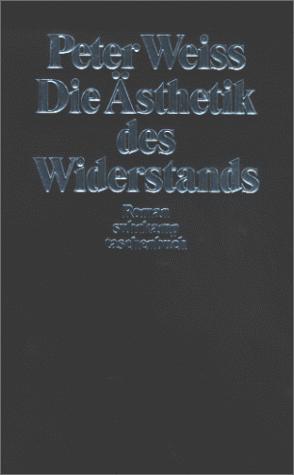Paperback
German language
Published Jan. 1, 1998 by Suhrkamp.

Paperback
German language
Published Jan. 1, 1998 by Suhrkamp.
The Aesthetics of Resistance (German: Die Ästhetik des Widerstands, 1975–1981) is a three-volume novel by the German-born playwright, novelist, filmmaker, and painter Peter Weiss which was written over a ten-year period between 1971 and 1981. Spanning from the late 1930s into World War II, this historical novel dramatizes anti-fascist resistance and the rise and fall of proletarian political parties in Europe. It represents an attempt to bring to life and pass on the historical and social experiences and the aesthetic and political insights of the workers' movement in the years of resistance against fascism.
Living in Berlin in 1937, the unnamed narrator and his peers, sixteen and seventeen-year-old working-class students, seek ways to express their hatred for the Nazi regime. They meet in museums and galleries, and in their discussions they explore the affinity between political resistance and art, the connection at the heart of Weiss's novel. Weiss …
The Aesthetics of Resistance (German: Die Ästhetik des Widerstands, 1975–1981) is a three-volume novel by the German-born playwright, novelist, filmmaker, and painter Peter Weiss which was written over a ten-year period between 1971 and 1981. Spanning from the late 1930s into World War II, this historical novel dramatizes anti-fascist resistance and the rise and fall of proletarian political parties in Europe. It represents an attempt to bring to life and pass on the historical and social experiences and the aesthetic and political insights of the workers' movement in the years of resistance against fascism.
Living in Berlin in 1937, the unnamed narrator and his peers, sixteen and seventeen-year-old working-class students, seek ways to express their hatred for the Nazi regime. They meet in museums and galleries, and in their discussions they explore the affinity between political resistance and art, the connection at the heart of Weiss's novel. Weiss suggests that meaning lies in the refusal to renounce resistance, no matter how intense the oppression, and that it is in art that new models of political action and social understanding are to be found. The novel includes extended meditations on paintings, sculpture, and literature. Moving from the Berlin underground to the front lines of the Spanish Civil War and on to other parts of Europe, the story teems with characters, almost all of whom are based on historical figures.
The three volumes of the novel were originally published in 1975, 1978 and 1981. English translations of volume I and II of the novel have been published by Duke University Press, respectively on 2005 and 2020.
(Source: Wikipedia)